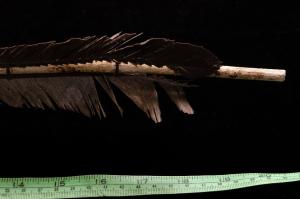
Joint news release with the Kwanlin Dün First Nation and the Carcross/Tagish First Nation
A new study, led by Kate Helwig and Jennifer Poulin at the Canadian Conservation Institute, has identified beaver castoreum as a component of the design and construction of a 6,000-year-old Yukon atlatl-throwing dart. As far as the authors know, this is the first instance where castoreum has been identified in an ancient archaeological context. The two-metre-long artifact was discovered melting free from alpine ice in the Traditional Territories of the Carcross/Tagish First Nation and the Kwanlin Dün First Nation in the fall of 2018.
The research study began when Valery Monahan, Yukon Museums Conservator and study co-author, found an unusual orange residue coating the sinews and wood at locations where different parts of the artifact were bound together. Analysis of these residues showed the substance was castoreum, a secretion beavers use to scent-mark their territory. Whether this substance was being applied as a preservative, an adhesive or a colourant is not known, but the use of beaver products by First Nations people in the subarctic north is renowned.
Similar studies of Yukon ice patch artifacts have previously identified a mix of spruce resin and red ochre applied as an adhesive. This discovery demonstrates yet again the sophisticated knowledge Yukon’s ancient First Nations people had about their environment, lands and resources. This knowledge allowed them to use a dynamic suite of materials to create and maintain the technologies that sustained them throughout the year.
Working in partnership with the six First Nations within whose Traditional Territories the ice patches are located has yielded unprecedented findings of ancient hunting tools and artifacts. These discoveries have led to a greater understanding of Yukon’s past. The study’s finding is testament to the incredible preservation of these artifacts and the information they hold, and illustrates just how much there is still to learn about how Yukon’s first peoples lived.
Minister of Tourism and Culture Ranj Pillai
Our ancestors were connected to the land, the water, and the animals in our Traditional Territories. They understood how to use the things around them to design complex and ingenious tools, like the atlatl. Shä̀w níthän to all of the people who worked together to bring this ancient technology into the light so our people can continue to learn from the knowledge of our ancestors.
Kwanlin Dün First Nation Chief Doris Bill
Our lands hold many secrets and insights into the past. Unearthing and studying these findings is valuable not just from a scientific and historic perspective, but culturally. Walking hand in hand with the land, water and wildlife is the history of our people. Their resourcefulness and ingenuity continue to impress and teach us. Gunalchéesh to the people helping keep us connected to our ancestors.
Carcross/Tagish First Nation Haa Sha du Hen Lynda Dickson
The Yukon Ice Patch Research Project is a collaborative initiative between the Carcross/Tagish First Nation, Champagne and Aishihik First Nations, Kluane First Nation, Kwanlin Dün First Nation, Ta’an Kwäch’än Council, Teslin Tlingit Council and the Government of Yukon.
Castoreum is a secretion produced in the castor sacs of beavers and is used to mark their territory. Comparative modern castoreum samples were provided by Peter Knamiller of Yukon’s Department of Environment.
The site where this artifact was found is on Canada’s Tentative List of sites to be nominated as a UNESCO World Heritage Site.
Throwing darts, which were thrown using a lever-like handle, were the preferred hunting projectile used by First Nations people in Yukon before the 7th century AD. They were locally replaced as a hunting weapon by bows and arrows around 847 AD.
Kate Helwig, Jennifer Herkes, Valery Monahan and Jennifer Poulin will be delivering a Beringia Centre Science Talk about the paper on June 17 at 11 a.m. PT livestreamed from the Yukon Beringia Interpretive Centre Facebook page.
Renée Francoeur
Cabinet Communications
867-334-9194
renee.francoeur@yukon.ca
Alicia Debreceni
Communications, Tourism and Culture
867-332-3670
alicia.debreceni@yukon.ca
Leighann Chalykoff
Communications, Kwanlin Dün First Nation
867-334-2012
Leighann.Chalykoff@kdfn.net
Stewart Burnett
Communications, Carcross/Tagish First Nation
867-332-3993
stewart.burnett@ctfn.ca